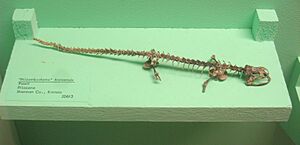Mole salamanders facts for kids
Quick facts for kids Mole salamanders |
|
|---|---|
 |
|
| Spotted salamander (Ambystoma maculatum) | |
| Scientific classification |
|
| Kingdom: | Animalia |
| Phylum: | Chordata |
| Class: | Amphibia |
| Order: | Urodela |
| Family: | Ambystomatidae |
| Genus: | Ambystoma Tschudi, 1838 |
Mole salamanders are a group of advanced salamanders found only in North America. They are famous for a few reasons. One is the axolotl (A. mexicanum), which is often used in science research because it stays in its baby form even as an adult. Another is the tiger salamander (A. tigrinum, A. mavortium), which is the official amphibian of many US states and is sometimes kept as a pet.
Contents
What Do Mole Salamanders Look Like?
Most adult mole salamanders live on land. They have wide, bulging eyes and thick arms. You can also see special grooves on their sides called costal grooves. Many species have bright patterns, like blue spots or yellow stripes, on a dark background.
These salamanders spend most of their lives underground in burrows. They might dig their own burrows or use ones left by other animals. In colder areas, some northern species will hibernate in these burrows during winter. They usually live alone and eat any small invertebrates they can find. Adults only go back to water, usually the ponds where they were born, when it's time to breed.
Life Cycle and Reproduction
All mole salamanders lay many eggs in clumps in the water. When the eggs hatch, the babies are called larvae. These larvae live completely in water. They have three pairs of feathery external gills behind their heads, which they use to breathe underwater. They also have large fins that run from their heads all the way to their tails.
Soon after hatching, larvae grow limbs. They have four toes on their front legs and five toes on their back legs. Their eyes are set wide apart and don't have eyelids yet.
Some larvae, especially in the southern parts of their range and tiger salamander larvae, can grow to adult size before they change into their adult form. This change is called metamorphosis. During metamorphosis, the larvae lose their gills and fins. Their tails, skin, and limbs become thicker, and their eyes develop eyelids. Their lungs also fully develop, allowing them to live on land.
Neoteny: Staying Young Forever
Some mole salamander species, and even some groups of species that normally live on land, are neotenic. This means they keep their larval (baby) form even when they become adults. The most famous example of this is the axolotl. Neotenic salamanders can't produce a special hormone called thyroxine that helps them change. If they are given this hormone from outside, they can sometimes change into a land-dwelling form, but this usually makes them live shorter lives.
Tiger Salamander Family

It used to be hard to tell different mole salamander species apart, especially within the "tiger salamander complex." This is because some populations stay in their larval form, and many tiger salamanders look very similar. They all have big heads, small eyes, and thick bodies. This might be because they have the original body shape of mole salamanders. They are also the largest mole salamanders and have very big larvae.
Even though they look similar and have similar lives, scientists found that tiger salamanders from far apart places are actually different species. Their living areas can overlap, and they sometimes breed with each other, which makes it even harder to tell them apart.
Over time, scientists have used new methods, like studying their genes, to identify different species. For example, the barred tiger salamander (A. mavortium) is now considered its own species. The California tiger salamander (A. californiense) was also found to be very different from other mole salamanders. The Plateau tiger salamander (A. velasci) was identified as a separate species in 1997. Scientists now believe that the axolotl (A. mexicanum) is not closely related to the tiger salamander (A. tigrinum) as once thought. Instead, the axolotl is likely closely related to the Plateau tiger salamander, as they live in the same area.
All-Female Salamander Groups
There are also special populations of mole salamanders that are all female. These groups are found in the Great Lakes region and northeastern North America.
Amazing Limb Regeneration
The axolotl (Ambystoma mexicanum) is a neotenic salamander famous for its amazing ability to regrow lost limbs. This makes it a very important animal for scientists who study how bodies can repair themselves.
When an axolotl regrows a limb, a special group of cells forms called a blastema. These cells can multiply quickly and turn into different parts of the new limb. During this process, the cells can get tiny breaks in their DNA. But the axolotl's cells are very good at fixing this DNA damage using a process called homologous recombination, which helps them rebuild the limb perfectly.
Naming and Classification
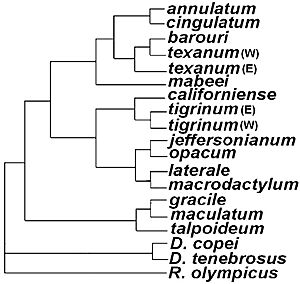
A group of salamanders called Rhyacosiredon used to be thought of as a separate type of salamander. But after studying them more closely, scientists realized that these salamanders are actually more closely related to some Ambystoma species than those Ambystoma species are to each other. This means Rhyacosiredon should be part of the Ambystoma group. Their unique body shape, which helps them live in streams, might have made scientists think they were a different group at first.
The name Ambystoma was given by Johann Jakob von Tschudi in 1839. It's usually thought to mean "cup-mouth." Tschudi didn't explain why he chose the name, so some people thought he meant to write Amblystoma, which means "blunt-mouth." You might even see old records using the name Amblystoma. However, since there's no clear proof that Tschudi made a mistake, the name Ambystoma is still used today.
Species of Mole Salamanders
There are 32 known species in the Ambystoma group. The newest one discovered is A. bishopi. Some of these species live on land, some stay in their larval (neotenic) form their whole lives, and some species have populations that do both!
| Image | Species and author | Common name | Distribution | Lifestyle | IUCN status |
|---|---|---|---|---|---|
 |
A. altamirani
Dugès, 1895 |
Mountain stream salamander, Achoque | Central Mexico, west and south of the Valley of Mexico | Terrestrial and neotenic | |
| A. amblycephalum
Taylor, 1940 |
Blunt-headed salamander | West-central Mexico (Michoacán state), near Morelia | Terrestrial and neotenic | ||
 |
A. andersoni
(Brandon and Krebs, 1984) |
Anderson's salamander | West-central Mexico (Michoacán state), Laguna de Zacapu | Neotenic | |
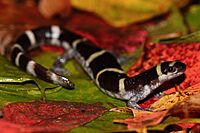 |
A. annulatum
Cope, 1886 |
Ringed salamander | South-central United States (Arkansas, Illinois, Missouri, Oklahoma), Ozark Plateau and Ouachita Mountains | Terrestrial | |
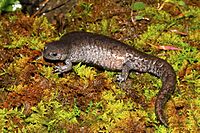 |
A. barbouri
Kraus & Petranka, 1989 |
Streamside salamander | South-midwest United States (Indiana, Kentucky, Ohio, Tennessee, West Virginia) | Terrestrial | |
| A. bishopi
Pauly, Piskurek & Shaffer, 2007 |
Reticulated flatwoods salamander | Southeast United States (Florida Panhandle and southernmost Georgia), west of the Apalachicola-Flint River | Terrestrial | ||
| A. bombypellum
(Taylor, 1940) |
Delicate-skinned salamander | Central Mexico (State of Mexico) near Jilotepec | Terrestrial | ||
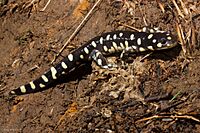 |
A. californiense
Gray, 1853 |
California tiger salamander | Central Valley of California | Terrestrial | |
 |
A. cingulatum
Cope, 1868 |
Frosted flatwoods salamander | Southeast United States (southern South Carolina and Georgia south to northern Florida) | Terrestrial | |
 |
A. dumerilii
(Dugès, 1870) |
Lake Pátzcuaro salamander, Achoque | West-central Mexico (Michoacán state), Lake Pátzcuaro | Neotenic | |
 |
A. flavipiperatum
Dixon, 1963 |
Yellow-peppered salamander, Ajolote de Chapala | West-central Mexico (Jalisco) | Terrestrial | |
 |
A. gracile
(Baird, 1859) |
Northwestern salamander | Northwest North America (southernmost Alaska to northern California) | Terrestrial | |
| A. granulosum
Taylor, 1944 |
Granular salamander, Ajolote | Central Mexico (State of Mexico) near Toluca | Terrestrial | ||
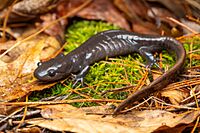 |
A. jeffersonianum
(Green, 1827) |
Jefferson salamander | Northeastern North America (Ontario south to Virginia and west to Illinois) | Terrestrial | |
 |
A. laterale
Hallowell, 1856 |
Blue-spotted salamander | Northeastern North America (Nova Scotia west to Manitoba and Minnesota and south to Indiana and New Jersey) | Terrestrial | |
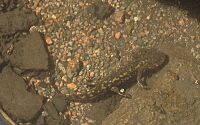 |
A. leorae
Taylor, 1943 |
Leora's stream salamander, Ajolote | Central Mexico (Mexico state - Puebla border), Mount Tlaloc | Terrestrial | |
| A. lermaense
(Taylor, 1940) |
Lake Lerma salamander | Central Mexico (State of Mexico), Lake Lerma near Toluca | Terrestrial and neotenic | ||
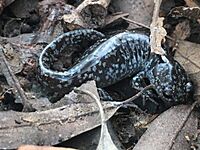 |
A. mabeei
Bishop, 1928 |
Mabee's salamander | Coastal southeast United States (southeast Virginia to South Carolina) | Terrestrial | |
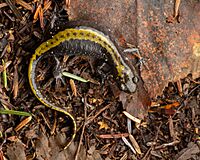 |
A. macrodactylum
Baird, 1950 |
Long-toed salamander | Northwest North America (Alaska south to northern California and east to Alberta and Montana) | Terrestrial | |
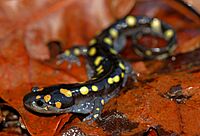 |
A. maculatum
(Shaw, 1802) |
Spotted salamander | Eastern North America (Nova Scotia west to Wisconsin and south to eastern Texas and Georgia) | Terrestrial | |
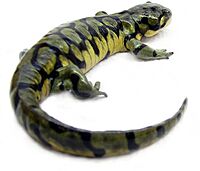 |
A. mavortium
Baird, 1850 |
Barred tiger salamander | Western North America (Manitoba south to Texas and west to Washington and California) | Terrestrial and neotenic | |
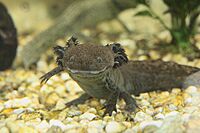 |
A. mexicanum
(Shaw and Nodder, 1798) |
Axolotl | Central Mexico (State of Mexico), Lake Xochimilco | Neotenic | |
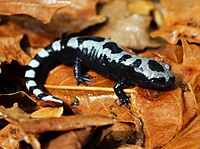 |
A. opacum
(Gravenhorst, 1807) |
Marbled salamander | Eastern United States (New Hampshire south to northern Florida and east to Missouri and Texas) | Terrestrial | |
| A. ordinarium
Taylor, 1940 |
Puerto Hondo stream salamander | West-central Mexico (Michoacán state), Puerto Hondo stream | Terrestrial and neotenic | ||
 |
A. rivulare
Taylor, 1940 |
Michoacan stream salamander | Central Mexico (western State of Mexico) | Terrestrial and neotenic | |
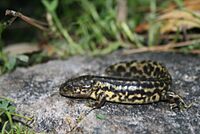 |
A. rosaceum
Taylor, 1941 |
Tarahumara salamander | Northwest Mexico, Sierra Madre Occidental | Terrestrial and neotenic | |
| A. silvense
Webb, 2004 |
Durango salamander | Northwest Mexico (Durango and Chihuahua), Sierra Madre Occidental | Terrestrial and neotenic | ||
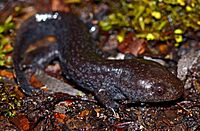 |
A. talpoideum
Holbrook, 1838 |
Mole salamander | Southeast United States (Virginia west to Oklahoma and south to northern Florida) | Terrestrial and neotenic | |
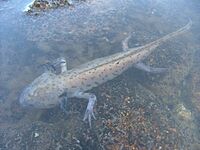 |
A. taylori
Brandon, Maruska, and Rumph, 1982 |
Taylor's salamander | Southeast Mexico (Puebla), Laguna Alchichica | Neotenic | |
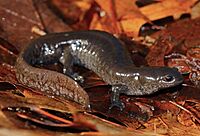 |
A. texanum
Matthes, 1855 |
Small-mouth salamander | South-central United States (Ohio west to Nebraska and south to Texas and Alabama) | Terrestrial | |
 |
A. tigrinum
(Green, 1825) |
Eastern tiger salamander | Eastern North America (New York northwest to Manitoba and south to Texas and northern Florida) | Terrestrial and neotenic | |
 |
A. velasci
(Dugès, 1888) |
Plateau tiger salamander | Mexican Plateau | Terrestrial and neotenic |
Sometimes, two groups of all-female hybrid populations are also given their own species names:
- Silvery salamander (A. platineum)
- Tremblay's salamander (A. tremblayi)
See also
 In Spanish: Ambystoma para niños
In Spanish: Ambystoma para niños
- Oophila amblystomatis


